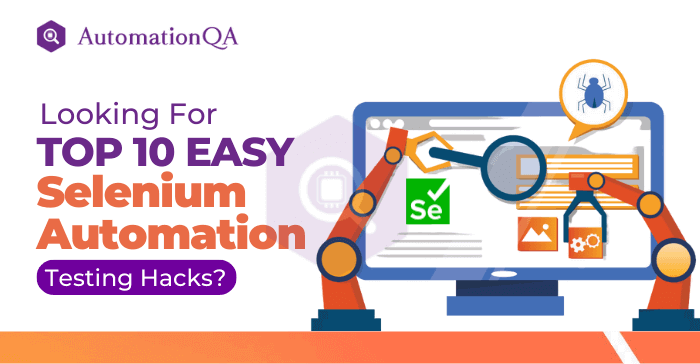
Are you a test automation specialist eager to level up your Selenium game? What does it take to excel in automation testing using Selenium? Are there any hacks that can save you time and effort while ensuring impeccable test coverage?
This blog post will reveal every answer by unveiling the ten advanced Selenium automation techniques for testers that will set them apart from the competition.
From intelligent waits to effective error handling, we dive deep into the intricacies of Selenium to equip you with the tools and knowledge you need to take your automation skills to the next level.
Introduction to Selenium
Before diving into Selenium, it is essential to grasp a few fundamentals of this powerful tool. The Selenium package encompasses the following testing tools.
A browser-based driver named Selenium WebDriver enables professionals to interact with and launch various browsers in different environments.
Test automation experts use Selenium IDE to modify, debug, record, and replay functional tests, which provides a feature-rich development environment.
Selenium Grid facilitates distributed test execution by enabling concurrent testing on numerous workstations running different operating systems and browsers.
Selenium Automation Testing
Jason Huggins developed a JavaScript program called JavaScript Test Runner to fix testing issues. Later, the developers modified the name of this automation program to Selenium.
The open-source tool Selenium is widely used for automatically testing web applications. It offers a framework for automating browser actions, including clicking buttons, filling out forms, and navigating between pages. It empowers you to write test scripts that simulate user interactions with a web application.. These scripts can be executed repeatedly, providing a reliable and efficient way to validate the functionality and behavior of web applications across different browsers and platforms.
Advanced Techniques to Take Your Selenium Automation Skills
Explicit Waits
You can use explicit waits to pause the execution of your test until a specific condition is satisfied. By using explicit waits, testers can ensure that your test waits for particular elements to be present, visible, or clickable before performing any actions. This technique helps prevent synchronization issues and improves the stability of your test scripts.
Headless Browser Testing
Headless browser testing refers to running your tests without a visual browser interface. This technique offers several advantages, including faster test execution, reduced resource consumption, and running tests in environments without a graphical user interface. Headless browser testing is beneficial for running continuous integration (CI) pipelines or executing server tests.
Cross-Browser Testing
Cross-browser testing ensures your web application functions correctly across different browsers and versions. By leveraging cross-browser testing, you can identify browser-specific issues early in the development cycle and provide a consistent user experience across other platforms.
Data-Driven Testing
Data-driven testing involves separating test data from test logic, allowing you to execute the same test script with multiple data sets. Selenium automation experts support data-driven testing by integrating with external data sources like Excel spreadsheets or CSV files, enabling you to run tests with different input values and expected outcomes.
Page Object Model (POM)
The Page Object Model (POM) is a design pattern encouraging the development of reusable and manageable test code. POM involves representing each web page as a separate class, encapsulating its elements and related actions. You can create a scalable and structured test automation framework by implementing POM.
Parallel Test Execution
Top automation experts provide options to execute tests in parallel, run tests in multiple browser instances, or distribute tests across multiple machines. Parallel test execution allows you to run multiple tests simultaneously, significantly reducing the overall test execution time. By harnessing parallel execution, you can achieve faster feedback on test results and accelerate the delivery of your web applications.
Logging and Reporting
Effective logging and reporting are crucial for automation testing. Selenium automation allows you to capture and log relevant information during test execution, such as debug messages, errors, or screenshots. Additionally, integrating reporting frameworks like TestNG or Extent Reports can provide comprehensive test reports with detailed information about test execution, failures, and coverage.
Test Configuration Management
Test configuration management involves maintaining different configurations for your test environment, such as URLs, credentials, or browser settings. Selenium companies provide various approaches to managing test configurations, including property files, environment variables, or external configuration files. Separating test configurations from test scripts allows you to switch between different environments and ensure test reproducibility easily.
Continuous Integration (CI) Integration
Integrating Selenium with a CI system like Jenkins or CircleCI enables you to automate the execution of your tests as part of the software development pipeline. CI integration ensures that tests are run automatically on code changes and provides timely feedback on the stability of your application. By configuring Selenium tests to run in your CI environment, you can catch issues early in the development cycle, promote faster bug fixes, and maintain high test coverage.
Advanced Locators
Efficiently locating elements on a web page is crucial for effective test automation. Selenium offers various locator strategies to identify factors, such as XPath, CSS selectors, and ID. An advanced locator can help you write robust and reliable test scripts. These Selenium techniques ensure your tests are not sensitive to minor changes in the structure or attributes of web elements.
Bottom Line
With these powerful Selenium automation techniques, you can become a true trailblazer in automation testing. Embrace the possibilities, experiment fearlessly, and let top automation consulting firms outshine. Are you ready to redefine the future of automation and leave a lasting impact on the industry?
